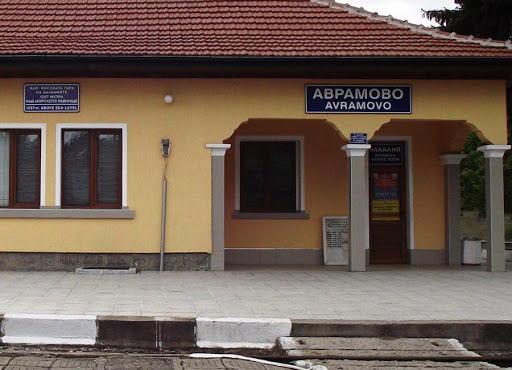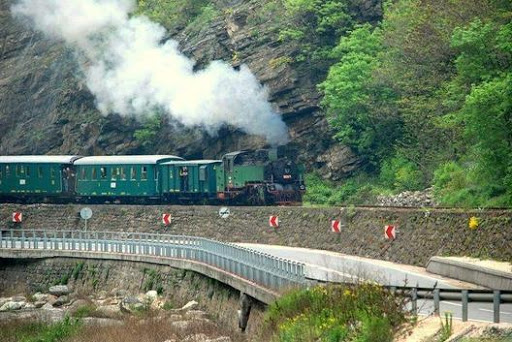Septemvri – Dobrinishte narrow-gauge line
If you even wish to experience an incredible adventure, we offer you to take a stroll with the narrow gauge-line Septemvri-Dobrinishte. We guarantee that at the end of the journey you will be relieved from your problems, you will be recharged with good emotions and you will get off the train smiling and happy.

Let‘s go…
Initial station – History of the narrow gauge-line
During the First World War, the Bulgarian government realized two things: the first is that many of the territories of the country are difficult to access and detached from the world, which makes them an easy „bite” for foreign appetites. The second thing is the Bulgarian army urgently needs wooden material and the only way to get it is from the forests in the Rhodope Mountain.
This is how the idea was born, namely to build a railway route that connects the almost detached at that time Rhodope Mountains with the Upper Thracian Plain, Pirin Mountain and Rila Mountain.
In 1916, the plan for the construction of narrow-gauge road was ready, and in 1920 the 19th National Assembly adopted a law on the construction of a narrow-gauge railway along the route Saranbey (Septemvri) – Ladzhene (Velingrad), Yakoruda, Razlog, Nevrokop (Gotse Delchev).
The digging on the route started in 1920, but due to the upcoming winter it was postponed for next year. From 1921 to 1926 the workers of the labor service succeeded and dug the gorge of Chepinska River and the route reached Ladzhene. The work was very difficult because workers had to drill the mountain almost without any equipment.
However, they managed to do so and in August 1926, at 11.00 a.m., from Snarabey the first narrow-gauge line has left the station. The train traveled on its way, followed by 2 – 3 wagons, it stopped at several stations and stops on its way and arrived at Ladzhene station for 3 hours and 22 minutes.
In the next year, the section Ladzhene – Chepino banya was opened, and in 1928 were laid the railway tracks of the section Varvara village – Pazardzhik.
Once the route reached Pazardzhik, the government adopted a law according to which the name of the Rhodope narrow gauge-road was changed to Tatar Pazardzhik – Nevrokop with a branch Varvara village – Saranbey. This change of the name of the narrow gauge-line was imposed because the idea was Pazardzhik to become first and last stop of the train.
The work continued for 9 more years and the next and most difficult section of the route was commissioned – from Chepino banya to Yakoruda.
In 1939, the section to Belitca station was ready, and Tsar Boris III has come for its opening, and he even drove the train along the route.
Four year later, the section Belitca – Razlog – Bansko was finished, and on 09.12.1945 was opened the last six kilometer long section from Bansko to Dobrinishte. After 1945 the construction work on the railway route has stopped and has not reached Gotse Dlechev.
Although the road remained unfinished according to the original plans, the narrow gauge-line Septemvri – Dobrinishte still performs its initial function to the present day, namely to provide transport connection from and to regions of the Rhodope Mountains that are hardly accessible.
Green traffic light – The adventure can begin
If you like the story about the creation of the narrow gauge-line, you will like even more the journey itself. Because you are about to travel on a 124.7 km long route, comfortably seated in a train that runs at an average speed of… 25 km/h on tracks with spacing of 760 mm.
In order to get from Dobrinishte to Septemvri with the narrow gauge-line you will need about 5 hours during which you will be able to enjoy the stunning views.
With the train you will go through a number of tunnels, enter dense forests, climb high up in the mountain, change direction a few times, you will go downhill, you will pass under and over bridges, you will stop at small, romantic stations and you will almost forget that the rest of the world exists.
Sights along the way of the narrow gauge-line Septemvri-Dobrinishte
If your trip starts from Dobrinishte, you will pass slowly and majestically through Bansko and Razlog, then you will continue through the incredibly beautiful Razlog valley. Right here the three mountains – Rhodopes, Pirin and Rila meet, and we are sure that you will not be able to stop watching through the windows of the narrow gauge-line and you will be amazed by the fascinating sights that will be revealed before your eyes.
And while you travel calmly and pleasantly, slightly sleepy because of the sound of the wheels of the narrow gauge-line, you will get to the Gulyina banya station and you will pass through the longest bridge on the route. Then the narrow gauge-line will start climbing up through the gorge of Mesta River on its way to the town of Belitca.
Once you reach Belitca you have two options – to continue with the train or to get off and have a walk along Belitca and the Park of dancing bears.
The park of dancing bears is located about 12 kilometers away from Belitca and it is one of the most popular tourist sites in the country. The reserve was opened in 2000 with the main goal to provide a place to the dancing brown bears where they can re-adapt.
If you decide to continue to the final station if the narrow gauge-line Septemvri-Dobrinishte, the train will take you with slow speed along Yurukovo and Yakoruda, and then it will start going up in the mountain to take you to one of the most beautiful places on the route – Avramovo station.
At a distance of only 9 kilometers, the narrow gauge-line will pass through 16 tunnels with total length of nearly 2500 meters, and it will overcome an altitude of 224 meters. Within this short distance the railway line will change its direction several times and it will reach the town of Avramovo – the highest alpine station in the Balkans (1276.4 meters)
Once you get there you can stay for a while to enjoy it through the windows of the narrow gauge-line or you can get off at the station and have a walk and a picnic and wait for the next train to continue your trip.

Avramovo station was built in a place where the border between Principality of Bulgaria and the Ottoman Empire passed from 1878 to 1912. The railway station was opened in 1937 and it was intended to trnsport the passengers on the route of the narrow gauge-line, and at that time it was one of the modern stations in the country. It had a guard room, waiting room, WC, water supply, house for the employees of the station, and security guard. Until 1983 the station was called Avramovi kolibi.
The tourist route to Veliitsa peak starts from the station.
After enjoying the amazing sights that are revealed from Avramovo station, the narrow gauge-line will take you through one of the most beautiful mountainous routes. You will pass through the longest tunnel on the route (315 meters), then you will descend about 10 kilometers until you reach the next station – Saint Petka.
On its way, the narrow gauge-line will enter and exit many tunnels, it will cross roads, pass over bridges, and will slowly pass through beautiful gorges until it reaches Velingrad- the SPA capital of Bulgaria.
Here you must get off the train and walk around the town. If you have time and you do not want to go back, you can stay in one of the numerous hotels that you will find in the town and enjoy a nice evening in the heart of the Rhodope Mountain.
But if staying in the town is not in your plans, then you can continue to the final destination of your trip – Septemvri station, or you can wait in Velingrad and return back along the route to Bansko or Dobrinishte.
Did you know that…
- The narrow gauge-line Septemvri – Dobrinishte is the only functioning narrow-gauge line in the country.
- Due to the difficult mountain terrain through which it passes, it is also called the „Alpine narrow gauge-line”.
- *The name „narrow gauge-line” comes from the small spacing which is 760 mm, while the spacing between the rails of regular trains is 1435 mm.
- The train stops at 12 stations and 13 stops from Septemvri station to Dobrinishte station. You also have the option, however, to request to get off at different place along the route, but you must inform the ticket-collector about your wish.
- At places the narrow gauge-line runs with a speed less than 20 km/h, so you can safely get off at some station and pick a bouquet of flowers for your girl and get back on the train while it is on the go.
- In order to pass from one wagon to another, you have to go outdoors and pass on the wooden „bridges” between the wagons.
- If you travel along the entire route, you will pass through 35 tunnels with total length of nearly 2858 kilometers.
- You can buy a ticket for the attraction steam locomotive if you want your trip to be even more amazing. On big holidays, the Bulgarian railway station launches the steam locomotive and in recent years it has become one of the biggest attractions that attracts tourists from all over the world. You can request a trip with the narrow gauge-line drawn by a steam locomotive for your tourist group, but you must make your request in advance.

The steam locomotive 609.76 was manufactured by the Polish plants Chrzanow, which was bought and commissioned by Bulgaria in 1949. In 2004, the locomotive was restored as a working locomotive and performs tourist and attraction trips.
- In the section between the Saint Petka stop and Avramovo station, the line of the route changes eight times, so it is called „figure of eight” (because of the shape formed by the route). After Avramovo there are two spiral descends (open and closed), which are called „sixes” (again because of the shapes formed by the route)
The narrow gauge-line is still one of the most convenient (and only) ways of transportation of the people living in the remote mountain villages along the route.